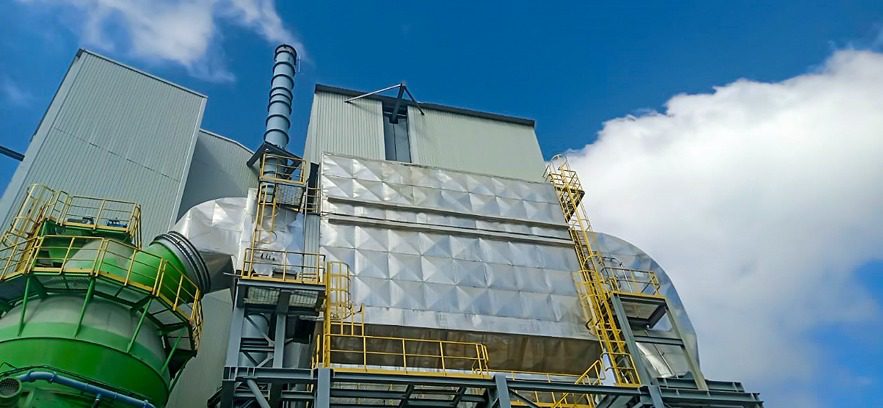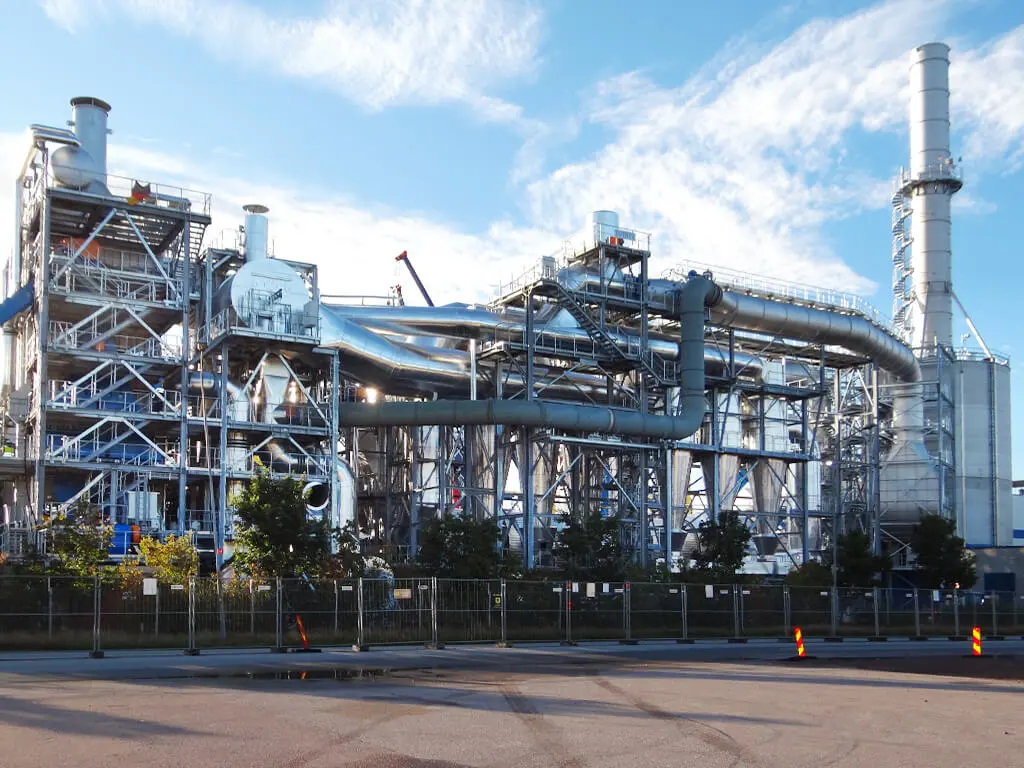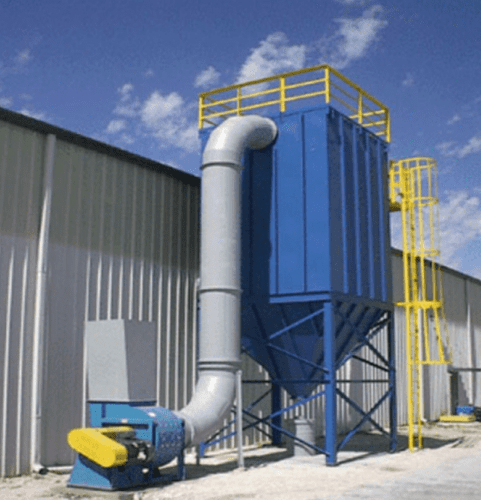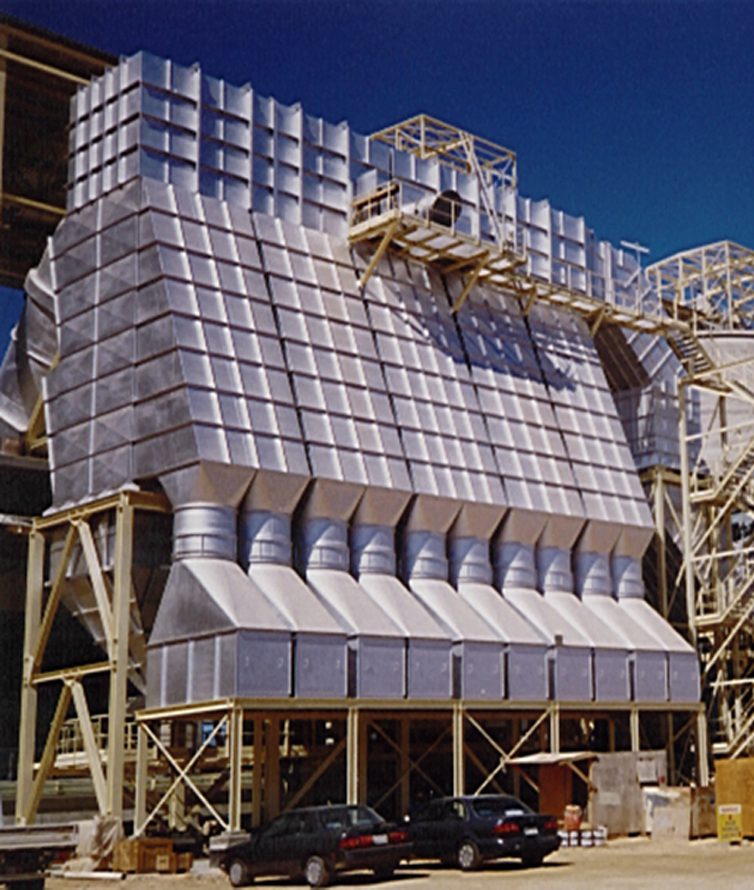The cement industry plays a vital role in global infrastructure development. However, its production process generates significant dust emissions, posing a threat to human health, environmental sustainability, and operational efficiency. Intensiv-Filter Himenviro offers a comprehensive suite of air filtration solutions specifically designed to address the unique challenges of the cement industry.
Throughout the cement production cycle, from raw material extraction and crushing to kiln operations and final product packaging, significant quantities of dust are generated. These fine particles pose a triple threat:
- Health Concerns: Exposure to cement dust can lead to respiratory problems such as asthma, silicosis, and other lung diseases. Workers in cement plants are particularly at risk, highlighting the importance of effective dust control measures to protect their health.
- Environmental Impact: Uncontrolled dust emissions pollute the surrounding air, impacting air quality and potentially harming nearby communities and ecosystems. Cement dust can also contribute to visibility reduction, creating a safety hazard.
- Operational Obstacles: Dust accumulation within the production facility can hinder equipment performance, leading to increased wear and tear, unplanned downtime, and ultimately, reduced production efficiency.
Therefore, addressing dust control is not just an environmental responsibility; it’s a critical factor for ensuring worker safety, operational efficiency, and the overall sustainability of the cement industry.
Sources of Dust in Cement Production
Cement production is a multi-stage process, and each stage presents a unique dust generation challenge. Let’s delve deeper into these key dust sources:
- Raw Material Handling and Crushing: The initial processing of raw materials like limestone, clay, and iron ore involves crushing and grinding, creating significant quantities of fine dust particles.
- Grinding Mills: Here, raw materials are further pulverized into a fine powder, generating even more dust with a high surface area, making it particularly problematic.
- Kiln Operations: The heart of the cement production process, the kiln involves heating the raw materials to extremely high temperatures to induce a chemical reaction that forms clinker. This high-temperature environment creates hot gas streams carrying dust particles.
- Clinker Cooling and Storage: Once clinker exits the kiln, it needs to be cooled down. This process also generates dust, and clinker storage piles can become a source of fugitive dust emissions if not properly managed.
- Final Product Handling and Packaging: The final stages of grinding clinker into cement and packaging the finished product can also contribute to dust generation.
Understanding these diverse dust sources is essential for designing and implementing effective air filtration solutions throughout the entire cement production process

The Heat is On: High-Temperature Challenges
One of the most significant challenges in cement dust control lies in the high temperatures encountered during kiln operations. Kiln exhaust gases can reach temperatures exceeding 1400°C (2552°F). Traditional air filtration technologies struggle in such extreme environments.
Here’s why high temperatures pose a challenge:
- Filter Media Degradation: Many conventional filter media materials cannot withstand such high temperatures and can melt or deteriorate rapidly, leading to frequent replacements and increased maintenance costs.
- Reduced Filtration Efficiency: High temperatures can affect the filtration efficiency of some systems, allowing dust particles to escape capture.
- System Design Constraints: Traditional filtration systems might require additional cooling stages to handle hot kiln exhaust gases, adding complexity and potentially compromising efficiency.
Therefore, effective dust control in cement production necessitates specialized filtration solutions designed to handle high temperatures while maintaining optimal performance and operational efficiency.
Intensiv-Filter Himenviro's Solutions: Advanced Dust Control Solutions
The fight against dust in the cement industry requires a multi-pronged approach. Here at Intensiv-Filter Himenviro, we offer a comprehensive arsenal of air filtration solutions specifically designed to tackle the unique challenges faced by cement producers. Our solutions address various dust sources and operating conditions, ensuring optimal dust capture and clean air emissions.
Electrostatic Precipitators (ESPs): Champions of High-Volume Capture

ESPs, or electrostatic precipitators, are workhorses in the air filtration industry, renowned for their exceptional efficiency in capturing fine particulate matter at high volumes. They are particularly well-suited for applications such as kiln exhaust gas cleaning in cement production.
The Science Behind the Spark:
ESPs leverage the power of electricity to attract and capture dust particles. Here’s a breakdown of how they operate:
- Ionization: High-voltage electrodes within the ESP ionize the incoming gas stream. This process strips electrons from gas molecules, creating positively charged ions.
- Particle Charging: As the dust particles pass through the ionized gas stream, they collide with the ions and become negatively charged themselves.
- Electrostatic Attraction: Collector plates within the ESP maintain a grounded electrical potential. This creates an electrostatic force that attracts the negatively charged dust particles to the collector plates
- Dust Removal: The collected dust accumulates on the collector plates. Periodically, a rapping mechanism dislodges the dust, allowing it to fall into a hopper for removal.
Benefits of ESPs for Cement Production:
- High Efficiency: ESPs achieve exceptional dust capture rates, exceeding 99.9% in some cases. This translates to cleaner emissions and reduced environmental impact.
- Large Capacity: They are ideally suited for handling high-volume gas streams generated by cement kilns.
- Adaptability: ESPs can be customized to various dust types and operating conditions within a cement plant.
- Durability: Modern ESP designs offer robust construction and reliable performance for extended service life.
However, ESPs also have limitations to consider:
- High Initial Investment: The initial installation cost of an ESP can be higher compared to some other filtration technologies.
- Energy Consumption: ESPs require a continuous supply of electricity to operate the high-voltage system.
- Maintenance Needs: Regular cleaning and maintenance of the collector plates and rapping mechanisms are crucial for optimal performance.
Reverse Air Bag Houses (RABHs): Taming the Heat
For applications involving high-temperature gas streams, such as clinker cooler exhaust gas, Reverse Air Bag Houses (RABHs) emerge as the ideal solution. Unlike conventional bag houses that rely on compressed air for cleaning, RABHs utilize a unique reverse air pulse cleaning mechanism.
The Art of Reverse Cleaning:
The RABH filtration process follows these steps:
- Dust Capture: Dusty gas enters the RABH and passes through filter bags, constructed from high-temperature resistant materials. Dust particles are trapped on the outer surface of the filter bags, while the clean gas exits the system.
- Reverse Pulse Cleaning: At programmed intervals, a compressed air pulse is injected into the top of each filter bag in a reverse direction (upward). This creates a momentary reverse airflow that dislodges the accumulated dust from the filter media.
- Dust Removal: The dislodged dust falls into a hopper located below the filter bags, where it can be collected and disposed of safely.

Benefits of RABHs for Cement Production:
- High-Temperature Capability: RABHs are specifically designed to handle high-temperature gas streams, making them ideal for clinker cooler exhaust applications.
- Efficient Cleaning: The reverse pulse cleaning mechanism effectively removes dust from the filter bags, ensuring optimal filtration performance.
- Energy Savings: Compared to traditional bag houses, RABHs require less compressed air for cleaning, resulting in lower energy consumption.
- Long Filter Bag Life: High-temperature resistant filter media and efficient cleaning mechanisms contribute to extended filter bag life, minimizing maintenance and replacement costs.
Considerations for RABHs:
Footprint: RABHs can have a larger footprint compared to some other filtration technologies due to the reverse air plenum design.
Initial Investment: Similar to ESPs, the initial investment for a RABH can be higher but offset by operational cost savings in the long run.
Pulse Jet Baghouses: Versatile Warriors for Diverse Needs
Pulse Jet Baghouses function similarly to RABHs in terms of dust capture and cleaning principles. Here’s a breakdown of the process:
- Dust Capture: Dusty gas enters the baghouse and passes through filter bags made from materials suitable for the specific dust type and operating temperature. Dust particles are trapped on the outer surface of the filter bags, while clean air exits the system.
- Pulse Cleaning: Compressed air pulses are injected into the top of each filter bag in short bursts. This creates a momentary expansion of the bag, dislodging the accumulated dust from the filter media.
- Dust Removal: The dislodged dust falls into a hopper located below the filter bags, where it can be collected and disposed of safely.
Benefits of Pulse Jet Baghouses for Cement Production:
- Versatility: Pulse Jet Baghouses can be adapted to various dust collection points throughout the cement production process due to their adaptability in terms of filter media and cleaning mechanisms.
- High Efficiency: They achieve excellent dust capture rates, contributing to cleaner air emissions and improved worker health.
- Compact Design: Compared to RABHs, Pulse Jet Baghouses can have a smaller footprint, making them suitable for retrofitting into existing facilities.
- Cost-Effective: They offer a balance between initial investment and operational costs, making them a popular choice for diverse dust control needs.

Considerations for Pulse Jet Baghouses:
- Temperature Limitations: While they can handle moderate temperatures, Pulse Jet Baghouses are not suitable for extremely high-temperature applications like clinker cooler exhaust.
- Compressed Air Consumption: The system relies on compressed air for cleaning, which can add to the operational costs.
- Maintenance Needs: Regular inspection and replacement of filter bags are necessary to maintain optimal performance.
Filter Media Selection: Choosing the Right Weapon for the Dust Battle
The effectiveness of any filtration system hinges on the selection of the right filter media. In the context of cement production, choosing the appropriate filter media is crucial due to the diverse characteristics of dust particles encountered throughout the process. Here’s what Intensiv-Filter Himenviro offers:
- High-Temperature Resistant Fabrics: For applications like clinker cooler exhaust, we provide filter media specifically designed to withstand high temperatures without compromising filtration efficiency or structural integrity.
- Abrasion-Resistant Fabrics: Cement dust can be highly abrasive. We offer filter media engineered to resist wear and tear, leading to extended bag life and reduced maintenance costs.
- Nano-Treated Fabrics: These advanced filter media feature a special surface treatment that improves dust cake release during the cleaning cycle, enhancing overall filtration efficiency.
- Hydrophobic Fabrics: For applications with moisture-laden dust, we provide hydrophobic filter media that repels moisture, preventing clogging and maintaining optimal airflow.
Complete System Design and Integration: A Tailored Approach
Intensiv-Filter Himenviro goes beyond providing individual filtration units. We offer a comprehensive service that encompasses the entire air filtration solution for your cement plant. Here’s what you can expect:
- On-Site Analysis: Our team of experts will conduct a thorough evaluation of your specific needs, including dust sources, gas flow rates, and temperature conditions.
- Custom System Design: We design and engineer a complete air filtration system tailored to your unique plant layout and dust control requirements.
- Selection of Optimal Equipment: We recommend the most suitable filtration technology (ESP, RABH, Pulse Jet Baghouse) along with the ideal filter media for optimal performance.
- Turnkey Installation and Commissioning: Our experienced technicians handle the entire installation process, ensuring proper integration with your existing infrastructure.
- Maintenance and Support: We offer ongoing maintenance and support services to ensure your air filtration system operates at peak efficiency.
By partnering with Intensiv-Filter Himenviro, you gain access to a complete air filtration solution that addresses the specific challenges faced by the cement industry. This ensures cleaner air emissions, improved worker health, enhanced operational efficiency, and regulatory compliance for your cement production facility.
Beyond Dust Control: The Broader Benefits of Effective Filtration
The implementation of efficient air filtration solutions in the cement industry extends far beyond simply capturing dust particles. It unlocks a range of positive effects that benefit not only the environment and worker health but also the overall operational efficiency and sustainability of the production process. Let’s delve deeper into these broader benefits:
1.Improved Air Quality: Effective dust control translates to cleaner air emissions from cement plants. This significantly reduces the concentration of harmful dust particles in the surrounding environment, leading to several advantages:
- Reduced Public Health Risks: Uncontrolled dust emissions can pose a significant threat to the health of communities residing near cement plants. By minimizing dust release, air filtration systems help safeguard public health by lowering the risk of respiratory illnesses like asthma and silicosis.
- Enhanced Visibility: Dust accumulation in the atmosphere can significantly reduce visibility, creating safety hazards for motorists and communities. Effective dust control contributes to clearer skies and improved visibility.
- Environmental Sustainability: Dust emissions can negatively impact ecosystems and biodiversity. By minimizing dust release, cement plants become better environmental stewards, protecting plant and animal life around them.
2.Enhanced Worker Safety: Cement dust exposure poses a serious health risk to workers within a cement plant. By implementing effective dust control measures, plant operators can create a much safer working environment:
- Reduced Respiratory Problems: Chronic exposure to cement dust can lead to various respiratory ailments. Efficient dust control minimizes worker exposure to dust particles, protecting their lung health.
- Improved Worker Wellbeing: Dusty work environments not only impact physical health but also contribute to fatigue and reduced worker satisfaction. Clean air within the plant creates a healthier and more pleasant working environment for employees.
- Compliance with Regulations: Occupational health and safety regulations increasingly mandate dust exposure limits within workplaces. Effective air filtration systems help cement plants comply with these regulations and ensure worker safety.
3.Increased Production Efficiency: Dust accumulation within the production facility can have detrimental effects on equipment performance and overall efficiency:
- Reduced Equipment Wear and Tear: Abrasive dust particles can damage equipment components, leading to increased wear and tear. Effective dust control minimizes this wear and tear, extending equipment life and reducing maintenance needs.
- Minimized Downtime: Dust-related equipment malfunctions and breakdowns can lead to unplanned downtime, disrupting the production schedule and costing money. Efficient air filtration systems prevent dust-related downtime, ensuring smooth operation and maximizing production output.
- Improved Product Quality: Dust contamination can affect the quality of the final cement product. By preventing dust from entering the production line, air filtration systems help ensure consistent and high-quality cement production.
4.Regulatory Compliance: Environmental regulations regarding air quality are becoming increasingly stringent. Cement plants face the responsibility of complying with these regulations to avoid penalties and operational disruptions. Here’s where effective dust control plays a crucial role:
- Meeting Emission Standards: Air filtration systems help cement plants meet established emission standards for dust particles. This ensures compliance with environmental regulations and avoids potential sanctions.
- Building a Positive Reputation: Demonstrating a commitment to environmental responsibility through effective dust control enhances the reputation of a cement plant. This can contribute to positive public perception and strengthen community relations.
- Future-Proofing Operations: By investing in advanced air filtration technologies, cement plants can prepare for potentially stricter regulations in the future, ensuring long-term compliance and sustainable operations.
5.Embracing Sustainability: The cement industry plays a vital role in infrastructure development, but it also has a responsibility to adopt sustainable practices. Efficient dust control contributes to this commitment in several ways:
- Reduced Resource Consumption: Minimized equipment wear and tear due to dust control translates to less frequent equipment replacements, lowering the overall resource consumption within the production process.
- Energy Savings: Modern air filtration systems are designed with energy efficiency in mind. By optimizing energy usage, cement plants can reduce their carbon footprint and contribute to a more sustainable future.
- Promoting Responsible Manufacturing: Investing in air filtration demonstrates a company’s commitment to environmental stewardship and responsible manufacturing practices. This can attract environmentally conscious customers and investors.
In conclusion, effective air filtration solutions in the cement industry go far beyond simply managing dust. These systems offer a multitude of benefits, impacting public health, worker safety, operational efficiency, regulatory compliance, and the overall sustainability of cement production. By prioritizing clean air emissions and adopting innovative filtration technologies, cement companies can take a significant step towards a more responsible and sustainable future.



